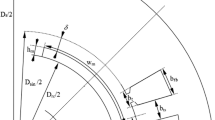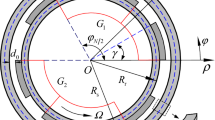Abstract
In this paper, the authors present a twin-armature rotary–linear permanent magnet (PM) motor. The stator consists of two armatures which generate two rotating magnetic fields and the rotor consists of two rigidly coupled parts. Each part consists of PMs on its surface which are skewed in opposite directions. By changing the direction of magnetic field rotation in each armature, the resultant force produced by the motor can be varied between rotary, linear, or rotary–linear. The torque and axial forces acting on the rotor are calculated by using 3-D finite element method analysis. The influence of the PM skew angle on the torque and linear force exerted on the rotor is investigated and presented. The effect of cogging torque and torque ripple reduction for the twin-armature rotary–linear PM motor is also discussed.

















Similar content being viewed by others
References
Fleszar J, Mendrela E (1983) Twin-armature rotary-linear induction motor. Electr Power Appl IEE Proc B 130(3):186–192
Mendrela E, Gierczak E (1987) Double-winding rotary-linear induction motor. IEEE Trans Energy Convers EC-2 #1:47–54
Pan JF, Cheung NC, Guagzhong Cao (2009) A rotary-linear switched reluctance motor. 3\(^{rd}\) International conference on power electronics systems and applications, pp 1–4
Mashino T, Toyama S (2008) Micro rotary-linear ultrasonic motor for endovascular diagnosis and surgery. 2008 IEEE international conference on robotics and automation, Pasadena, CS, USA, pp 3600–3605
Amiri E, Jagiela M, Dobzhanskyi O, Mendrela E (2013) Modeling dynamic end effects in rotary armature of twin-armature rotary-linear induction motor. IEEE international electric machines and drives Conf. (IEMDC (2013) Chicago, IL, USA, pp 1088–1091
Shimomura S, Fuijeda M, Hoshino K (2009) Studies to decrease cogging force and pulsating thrust in the prototype linear permanent magnet vernier motor. International conference on electrical machines and systems, 2008, IEEE transactions on magnetics, pp 3417–3422
Mendrela E (2004) Electric machines. Louisiana State University, Course Pack
Liu GR, Quek SS (2003) Finite element method, a practical course, Linacre House, Jordan Hill, Oxford OX 8DP, pp 3–9
Fanslow M (2009) Considerations in the selection and application of AC and DC motors for cement plants. IEEE Cement industry technical conference record, pp 1–22
Meeker D (2006) Finite element method magnetics—Version 4.0, User’s Manual
Mendrela E, Fleszar J, Gierczak E (2003) Modeling of induction motors with one and two degrees of mechanical freedom, Kluwer/Dordrecht/London, pp 50–55
Masatami I, Eiichi O, Toshio I, Yoshiyuki S (1973) End-effect of high speed linear induction motor. IEEE Trans Ind Appl 6:632–639
Eastham JF, Balchin MJ, Coles PC (1988) Full-scale testing of a high speed linear synchronous motor and calculation of end-effect. IEEE Trans Magn 24(6):2892–2894
Pan JF, Cheung NC, Guagzhong Cao (2009) A rotary-linear switched reluctance motor, 3rd international conference on power electronics systems and applications
Mashino T, Toyama S (2008) Micro rotary-linear ultrasonic motor for endovascular diagnosis and surgery. 2008 IEEE international conference on robotics and automation, Pasadena, CS, USA, May 19-23, pp 3600–3605
Chen L, Hofman W (2007) Design of one rotary-linear permanent magnet motor with two independently energized three phase winding. International conference on power electronics and drive systems, pp 1372–1376
Chen L, Hofman W (2007) Design of one rotary-linear permanent magnet motor with two independently energized three phase windings. International conference on power electronics and drive systems, pp 1372–1376
Mohan N (2007) Advanced speed drives, pp 132–134
Fei W, Luk P (2008) Cogging torque reduction techniques for axial-flux surface-mounted permanent-magnet segmented-armature-torus machines. IEEE Trans Magn 485–490
Muljadi E, Green J (2002) Cogging torque reduction in permanent magnet wind generators. NREL/CP-500-30768, pp 1–6
Yao YD, Huang GR, Wang JC, Liou SH, Ying T (1997) Simulation study of the reduction of cogging torque in permanent magnet motors. IEEE Trans Magn 33(5):4095–4097
Belikov V, Ivlev A, Chelak V (1980) Electrical motor having helical stator. US patent. Patent No: US4439702 A
Author information
Authors and Affiliations
Corresponding author
Rights and permissions
About this article
Cite this article
Dobzhanskyi, O., Gouws, R. 3-D Finite element method analysis of twin-armature permanent magnet motor with two degrees of mechanical freedom. Electr Eng 99, 997–1004 (2017). https://doi.org/10.1007/s00202-016-0454-6
Received:
Accepted:
Published:
Issue Date:
DOI: https://doi.org/10.1007/s00202-016-0454-6




